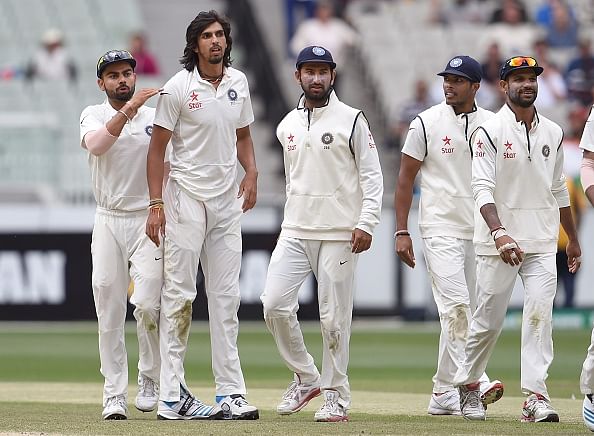
India’s impotent tail
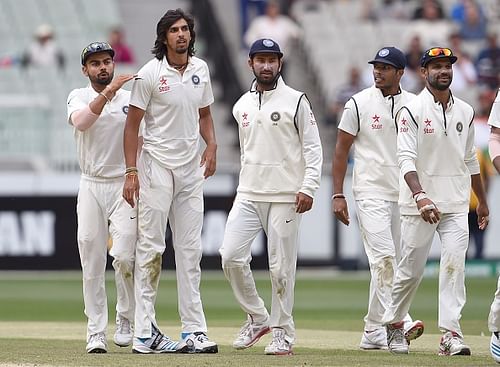
From 409/4 to 462/8 and then 465 all out: I believe India has perfected the technique of surprising the opposition with some extremely ordinary batting when close to half the number of batsmen are back in the pavilion. After all, why make the opposition bowlers exert and strive hard to take wickets? Things are made easy when the wickets are simply given away, eh? It certainly seems that way.
What has been the prevailing pattern with India’s away performances is the utter absence of ‘team performances’. Either the opener will shine and the others will fall limp one after another, or the number four will play scintillating innings, all the while lacking the paramount support that he needs from his team, or the number five will play composed innings trying to salvage some sort of dignity, while all around him will be just a meaningless melee.
Of what use is individual brilliance if not supported and augmented by team performances?
In the series at South Africa towards the fag end of 2013, India drew one match and lost the other (by 10 wickets). And the tail was consistent in being a no show.
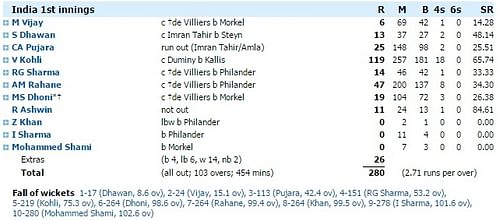
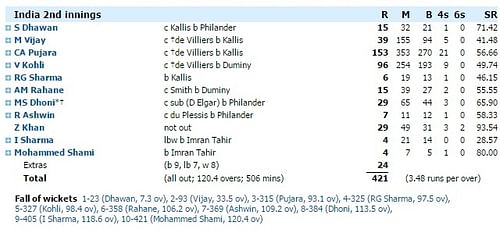
From 264/6, India fell to 280 all out, with three wickets, three significant wickets of Dhoni, rahane and Zaheer Khan falling at 264. While this was the script for the first innings, the second innings offered something different, but alas, in the same flavor. The tail contributed just 44 runs to the total, as India fell from 358/6 to 421 all out.
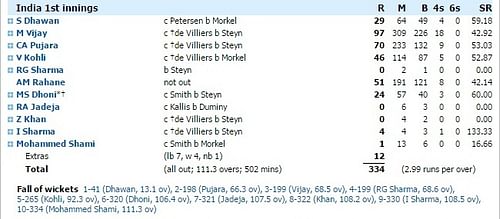
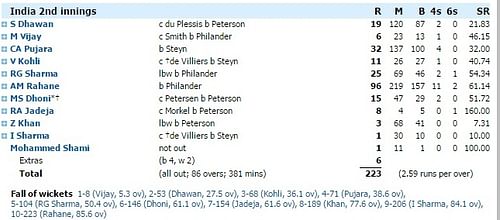
India fell from 320/6 to 334 all out in one vintage vacant showing by the tail. In the second innings, the tail bettered its first innings cumulative score and notched up 13 runs as India’s innings was brought to an almighty end from 146/6 to 223 all out. (That match though announced the tru arrival of a certain Ajinkya Rahane, who braved through with a knock of 96, and notched up some important [ultimately inconsequential] runs with the tail).
Consider the away series for India in England earlier this year. India suffered colossal defeats in the third, fourth and fifth tests. One major contributing factor to those massive defeats could be the performance-rather the non performance-of the Indian tail. (Admittedly, Bhuvneshwar Kumar did come in so very handy with the bat earlier).
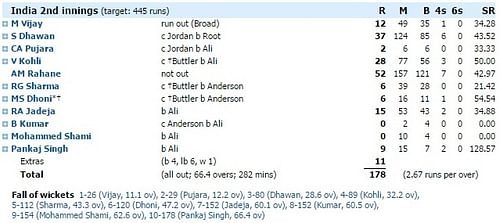
A cursory glance would highlight that India went from 112/5 to 152/7 to 178 all out.
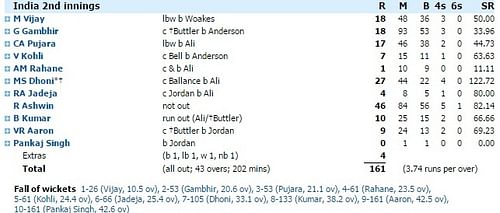
A more heavy and painful defeat. The Indian batting innings admittedly never took off, but the way the tail cooped up into a coccon cannot be passed over: from 105/7 to 161 all out. Ravichandran remained unbeaten on a valiant 46, but it was ultimately for nothing, seeing that the batsmen at the other end continued to get skittled out cheaply.
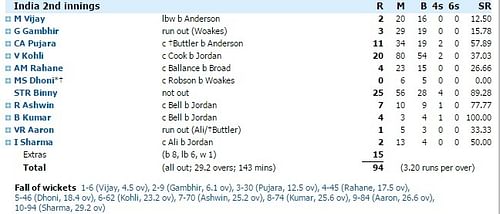
I saved the best for the last, as you can see (so did India by the way). That is a capitulation of some insane order, as the Indian innings never took off, and the tail accounted for just 14 runs of the total.
The reason I have highlighted the second innings batting performances of India is to showcase how the tail’s shortcomings are putting the brakes heavily on India’s quests to notch up wins.
In a chase of 407 runs and at 248/4, it still looked as if India would fight for a win against New Zealand in the first test at Auckland. But anything but that transpired as the tail folded from being 324/7 to being getting cleaned up for 366.
There are eleven players in any line up. If every individual had to do just batting or bowling then selecting the best eleven would be an unenviable headache. A substantial amount of work is expected from all players in all the departments of batting, bowling and fielding.
Of course, one does not expect a specialist batsman to take five wicket hauls every match; nor are dedicated bowlers expected to score centuries consistently. What is expected though is some sort of significant contribution to the team’s cause, when their services are called upon.
In that regard, India’s tail is notorious for being an inert, incapable, insolent and redundant part of the line up. It is not often that an opener notches up a 100+ score against a tenacious and potent attack; it is not an everyday occurrence that the one down and two down batsmen scoop up runs however they can to add some meaning to the teams’ total; alas it seems as if the tail is extremely consistent in being impotent.
Batting collapses on away tours have been unsurprising, regular occurrences in the realm of Indian cricket. The tail is expected to support the batsman in the crease, but little hope is attached to those expectations. It is a well known fact that if the Indian tail is exposed, it immediately shies away in between the legs.
Time and time again, the tail crumbles any and all expectations of salvaging a meaningful result from a test. India can very well curtail its innings after it is five or six down. Nobody is entertained by a morose tail. Believe me, nobody.
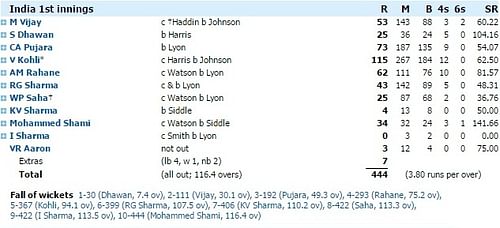
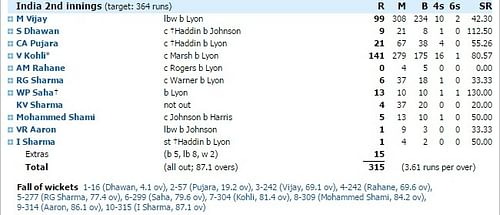
Vijay, Rahane and Kohli especially had batted wonderfully well to lead India’s reply to Australia’s rather daunting first innings total of 517. All was well when Kohli fell at 367/5. Apparently not. The tail folded as India put on just 77 runs more.
In the second innings, with India needing 364 runs, Virat Kohli donned on an attacking and rather intimidating assault on the Aussies and it seemed as if the stand-in skipper was on his way in leading the team to a famous and gritty win, until the tail showed up. 13, 4, 5, 1 and 1 were the flattering scores of the tail, as India was bowled out for 315 from being 242/4 and 299/6.
The second test in Brisbane saw India notch up 408 in the first innings, which seemed a good total. But that also did not eclipse the tail’s return of 9, 4 and 1. Mitchell Johnson bamboozled the Indian attack with an exhilarating counter punch of an innings as he notched up 88 in the company of his captain. Mitchell Starc, Nathan Lyon and Josh Hazlewood came up with useful totals of 52, 23 and 32 (n.o.).
This foretold of trouble for India and spelled definite doom when India’s tail cooked up no valiant tale like the Aussie tail had done. India went on to lose the match, despite some late bowling heroics. Those efforts, although valiant, were just too little, too late.
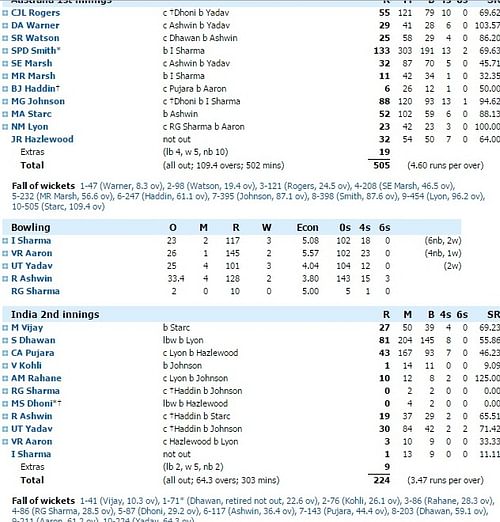
It certainly is not enough for the batsmen to score when they can. While all the batsmen cannot always strike gold simultaneously, support, how much ever feasible, if rendered to the batsman in form, would be invaluable. And such support would be of infinite value if the tail produced it, because more often than not, the tail is exposed and is expected to whiff up a fight to save matches. Sadly, more often than not, the tail never turns up to play.
-A fan put off by a spineless tail.